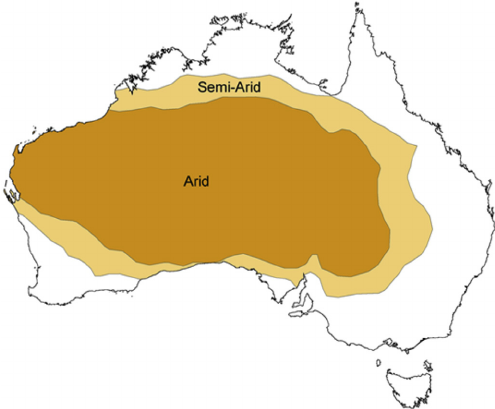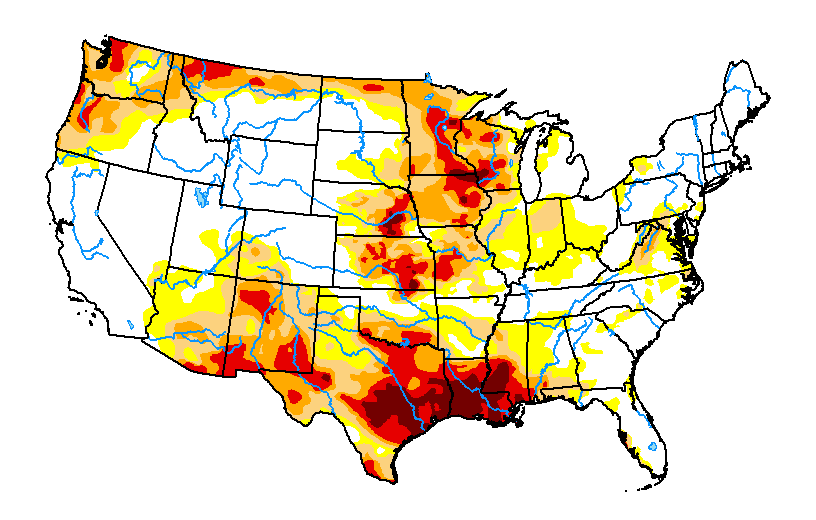
How Much Land is Arid or Semi-Arid, and What Will It Take to Make It Ready for Agriculture?
(This is part 2 of a 6-part series exploring transforming arid areas with water)
In our last blog, we discussed the possibilities of transforming arid and semi-arid areas with the introduction of sufficient water. In this second installment, we’ll dive deeper into the amount of land classified as arid or semi-arid in Australia and the USA. We’ll also explore how long it might take to turn this land into productive agricultural areas and examine the role of permaculture in achieving sustainable transformation. Additionally, we’ll consider how deep-seated groundwater resources, and the technologies offered by companies like AquaterreX, can bring much-needed water to these regions, making the transformation both possible and sustainable.
Arid and Semi-Arid Lands: Australia and the USA
Both Australia and the USA have significant portions of their land classified as arid or semi-arid, meaning that water scarcity is a critical challenge in these areas. Despite these challenges, this land represents a tremendous opportunity for development if we can find sustainable ways to introduce water and make the soil productive.
Australia
In Australia, roughly 70% of the land is classified as arid or semi-arid. This covers vast expanses of the country’s interior, including the Simpson and Great Victoria Deserts, as well as significant portions of Western Australia, South Australia, and Queensland. The dominant use of these lands today is low-intensity grazing, where livestock is raised in sparse environments with limited vegetation. Australian Government

Pudmenzky, Christa & King, Rachel & Butler, H.. (2015). Broad scale mapping of vegetation cover across Australia from rainfall and temperature data. Journal of Arid Environments. 120. 55-62. 10.1016/j.jaridenv.2015.04.010.
The USA
In the United States, around 40% of the land area is considered arid or semi-arid, primarily concentrated in the western states like Nevada, Arizona, and New Mexico. These regions are famous for their vast deserts and dry plains, where water is often a limiting factor for agriculture. However, with the right interventions, these areas could support a much more diverse range of agricultural activities. Most importantly, these solutions can be applied to arid regions around the world. HowStuffWorks Science

USA US Drought Monitor Sept 2023-Sept 2024
How Long Might It Take to Make the Land Ready?
Turning arid or semi-arid land into agriculturally viable areas is a complex process, but with the right strategies, it is possible to achieve significant progress within a few years. Several key steps must be taken to make the land ready for agriculture: improving the soil, securing a steady water supply, and selecting crops suited to the new environment.
1. Soil Improvement and Remediation
In arid and semi-arid regions, soils tend to be nutrient-poor, with limited organic matter and a high risk of erosion. Before planting crops, the soil must be improved through the addition of organic materials such as compost and mulch. In areas with saline soils, soil amendments like gypsum may be required to lower salt concentrations and improve soil fertility. Depending on the initial condition of the soil, this process could take between 1 to 5 years before the land is ready for full agricultural use. Science Direct
2. Irrigation and Water Management: Tapping into Deep-Seated Groundwater
Water is the single most important resource for transforming arid land into productive farmland. In many cases, surface water and rainfall are insufficient to meet the needs of agriculture in these regions. This is where technologies like those offered by AquaterreX can play a transformative role. Technology
AquaterreX specializes in the exploration and identification of Deep Seated Water (DSW)—freshwater reserves that exist far beneath the surface. Unlike shallow aquifers, which are often overused and subject to depletion, Deep Seated Water offers a more sustainable, untapped resource that can be used to irrigate crops in arid regions. Indeed, the US National Groundwater Association estimates there is 6,000 years of global water supply in the upper two kilometers (6500 feet) of the earth’s crust. By using advanced digital mapping technologies and patented scientific instrumentation, AquaterreX can locate these deep-water reserves with a high degree of accuracy, allowing farmers and land developers to tap into a reliable source of water that can sustain agriculture even in the harshest conditions.
Once these water resources are identified, installing efficient irrigation systems—such as drip or precision irrigation—can maximize water usage and prevent wastage. This process can begin as soon as the water source is confirmed, but managing these water systems effectively requires continuous monitoring and adjustment to prevent issues like soil salinization. With a combination of modern irrigation techniques and the use of Deep Seated Water, it is possible to make land productive within 3 to 5 years, depending on the scale of the project.
3. Planting and Growth Cycles
After improving the soil and securing a reliable water source, planting can begin. The choice of crops will depend on the climate and soil conditions, but in many cases, it may be necessary to start with drought-tolerant plants to establish a stable ecosystem. Over time, as the soil improves, more intensive crops can be planted, leading to increased agricultural productivity. This process could take several years, but within a decade, much of the land could be transformed into fertile, productive farmland.
The Role of Permaculture in Sustainable Transformation
While traditional farming methods can help bring arid land into production, permaculture offers a more sustainable approach that works in harmony with natural ecosystems. Permaculture is based on principles of ecological design and emphasizes the conservation of resources, particularly water and soil. Permaculture Research Institute

1. Water Conservation
One of the key principles of permaculture is water conservation, which is especially important in arid and semi-arid regions. Permaculture techniques like swales (shallow channels to capture rainwater) and keyline design (landscaping to optimize water flow) help retain moisture in the soil and prevent erosion. These methods reduce the need for external irrigation, making the land more resilient to drought conditions.
2. Soil Building
In permaculture, building healthy soil is a continuous process. Techniques such as composting, cover cropping, and mulching add organic matter to the soil, improving its structure and fertility. Over time, these practices can help restore degraded soils, allowing them to support a diverse range of crops. Deep-rooted plants are particularly valuable in permaculture systems, as they break up compacted soil and help water penetrate deeper into the ground, where it can be stored and used more effectively.
3. Biodiversity and Ecosystem Support
Permaculture emphasizes biodiversity, encouraging farmers to plant a variety of crops, trees, and other plants that work together to create a balanced ecosystem. This diversity can improve soil health, reduce pest problems, and increase resilience to climate extremes. By mimicking natural ecosystems, permaculture systems become more self-sustaining over time, requiring less input from farmers in terms of water, fertilizers, and labor.
4. Long-Term Sustainability
One of the greatest advantages of permaculture is its long-term sustainability. Once a permaculture system is established, it requires minimal external inputs, making it an ideal solution for transforming arid regions into productive, self-sustaining agricultural areas. With the right design and management, permaculture can help restore degraded land and create new opportunities for agriculture in some of the world’s harshest environments.
Paving the Way for a Sustainable Agricultural Future
Transforming arid and semi-arid lands into productive agricultural areas is a challenging but achievable goal. In countries like Australia and the USA, where large amounts of land fall into these categories, innovative water management technologies and sustainable farming practices can make all the difference. Companies like AquaterreX, with their ability to locate deep-seated groundwater, offer a vital solution to the water scarcity problem. When combined with soil remediation, efficient irrigation, and the principles of permaculture, these lands can be made productive in as little as a few years. The key to success lies in working with nature, harnessing both the technological tools available and the regenerative power of ecosystems to create a sustainable agricultural future.
This blog article is part 2 of a 6-part series exploring transforming arid areas with water. Stay tuned for part 3 soon. If you missed Part 1, read it here What If We Could Bring Water to Arid and Semi-Arid Areas?